CONTACT THE NEW YORK TIMES PUBLIC EDITOR AND DEMAND CHANGES IN TIMES’ REPORTING. SEE RED BOX AT BOTTOM OF REPORT.
-
New York Times coverage often supports the Palestinian narrative without placing events in greater context.
-
Headlines, eyewitness accounts, and images depicted the Gaza conflict as Israeli aggression against Palestinian civilians.
-
Settlements are misrepresented by having images of tiny outposts accompany articles about settlements.
-
Issues such as Palestinian incitement are downplayed or ignored.
The Bullets in Bronner’s Inbox
 At the end of January, as the conflict in Gaza was winding down, New York Times Jerusalem Bureau Chief Ethan Bronner defended himself against charges of bias in an opinion piece titled “The Bullets in My Inbox.” He writes about being attacked by both those who are pro-Israel and pro-Palestinian when he fails to write a story supportive of either side’s selective narrative.
At the end of January, as the conflict in Gaza was winding down, New York Times Jerusalem Bureau Chief Ethan Bronner defended himself against charges of bias in an opinion piece titled “The Bullets in My Inbox.” He writes about being attacked by both those who are pro-Israel and pro-Palestinian when he fails to write a story supportive of either side’s selective narrative.
There are also blogs and chat sites on both sides that spend time accusing all the journalists here of having agendas because our articles mention facts or trends that they consider a diversion from the real story.
He concludes by agreeing with one e-mail he received that said:
You should not be a reporter if you are not telling the whole story, not just the parts that sell.
We agree with Bronner’s conclusion so we decided to see if the New York Times was following its reporter’s advice and telling the whole story. We looked at a total of 165 articles published in the Times during the first half of 2009. We examined not only what the Times reported, but also what was omitted (or reported very rarely). We concluded that the New York Times does not “tell the whole story” but often prints articles, pictures and quotations that lean towards the Palestinian perspective. While we respect Bronner’s approach, the reality is that Times coverage does not always live up to his own standards.
The Gaza Conflict
The Palestinian perspective of the Gaza conflict portrays Israeli military action as disproportionate and resulting in massacres of civilians and other war crimes. Israel sees Operation Cast Lead as the inevitable result of years of bombardment from the Gaza Strip on nearby Israeli towns and cities. While Hamas hid in civilian areas, the Israel Defense Forces were careful to minimize actions that would endanger Palestinian civilians. Did the Times report both narratives equally? Did they try and put the conflict into perspective and tell the “whole story?”
Eyewitness Accounts
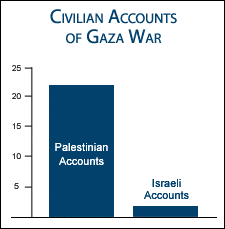 The Times uses a large number of Palestinian “eyewitness” accounts of alleged Israeli atrocities. Due to Israeli restrictions on media entering Gaza during the fighting, such accounts had to be collected by Palestinian stringers and could certainly not be verified or corroborated. While the Times stood by its Palestinian journalists (see the Bronner piece above), the reality is that it was rare to find Palestinians willing to speak openly of Hamas activities within civilian areas for fear of retribution. (See Backspin for more about the impact of journalist intimidation in Gaza.) While it is true that the Israeli policy made coverage of the war difficult, that is no excuse for biased reporting.
The Times uses a large number of Palestinian “eyewitness” accounts of alleged Israeli atrocities. Due to Israeli restrictions on media entering Gaza during the fighting, such accounts had to be collected by Palestinian stringers and could certainly not be verified or corroborated. While the Times stood by its Palestinian journalists (see the Bronner piece above), the reality is that it was rare to find Palestinians willing to speak openly of Hamas activities within civilian areas for fear of retribution. (See Backspin for more about the impact of journalist intimidation in Gaza.) While it is true that the Israeli policy made coverage of the war difficult, that is no excuse for biased reporting.
These unverified accounts are so graphic as to leave little room for explanations. Accepting these quotes at face value, a reader will naturally conclude that there had been a consistent pattern of war crimes by the Israel Defense Forces.
While some of the articles later provide official IDF rebuttals of these accounts, the quotations impact the story so much more. A Palestinian quoted as saying “I don’t understand why Israel would hit an ambulance” becomes part of the documented history of the conflict, regardless of whether Israel actually targeted ambulances or whether those ambulances were being commandeered by Hamas terrorists. Here are just a few of the 21 such quotations that were included in the Times articles:
-
“He was just doing his work,” said the dentist, who would not give his name. “He’s a doctor, and I can’t understand why Israel would hit an ambulance. They can tell from the cameras it’s an ambulance.”
-
“There is no water, no electricity, no medicine, It’s hard to survive. Gaza is destroyed.”
-
“I want her leg now!” Fida screamed at her mother, blaming her for moving them to the concrete house. “God has no mercy! You get me her leg now!”
-
“I dont know what kind of weapons Israel is using,” said a nurse, Ziad Abd al Jawwad, 41, who had been working 24 hours without a break. “There is so much amputation“.
-
“My son has been turned into pieces,” he cried. “My wife was cut in half. I had to leave her body at home.”
-
“I could feel the blood dripping inside my head,” Ahmed said, recalling the days he lay wounded in the bombed-out building. “My father was crawling he couldn’t move his legs,” he said. “I have nine children,” he said. “Where can I go? I prefer to die at my own house.”
-
“They killed the elders, the children, the women, the animals, the chickens,” said Subhi, 55, Rizka’s brother. “It’s a nightmare. I never thought I would lose all of them.”
-
“Israel is breeding extremists. The feeling you get is that they just want you to leave Gaza.”
-
“They hit my future with a rocket,” said Muhammad Baroud, one of the students at the Islamic University in Gaza City. “
This is a university. What does it have to do with war?” -
“The children were screaming, ‘Fire! Fire!’ and there was smoke everywhere and a horrible, suffocating smell,” she said. “My 14-year-old cried out, ‘I’m going to die. I want to pray.’ I saw my daughter-in-law melt away.”
On the other hand, there were only two quotations in the Times articles from Israelis living in areas hit by Palestinian rockets during the time period of the study. While it is true that during the conflict, the vast majority of the casualties were Palestinians, these accounts don’t even come close to describing the fear and trauma of living under daily threat from rocket attacks. Over the last few years, more than 7,000 rockets have been launched at Israeli communities. Yet the Times rarely found eyewitness accounts that capture the anguish of Israelis who have suffered from Palestinian attacks. Do Israelis living in Sderot and Ashkelon just not care anymore? That is certainly the impression one gets.
-
“I do not feel any victory,” Mr. Katzir said. “I still do not feel safe.”
-
Rachel Uliel, 75, was leaning on the front gate of her house, which was festooned with Israeli flags. “I feel very good now,” she said, “though I do not know what will come next.”
The Times used 21 direct quotations from Palestinian civilians pertaining to life during the Gaza conflict and only two from Israelis. Where is the balance? Where is the objectivity? Where is the Times’ commitment to tell the “whole story?” Or are Israeli civilian accounts just a “diversion from the real story?”
Headlines
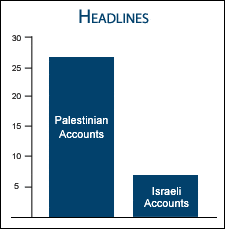 The Times published 75 articles related to the Gaza conflict during the time period we reviewed. Twenty-seven articles led with headlines related to civilian casualties or accusations of human rights abuses. Examples of such headlines include:
The Times published 75 articles related to the Gaza conflict during the time period we reviewed. Twenty-seven articles led with headlines related to civilian casualties or accusations of human rights abuses. Examples of such headlines include:
Many of the 27 articles did also include Israel’s explanations. However, the headlines hardly convey any sense of balance. They instead provide support for Palestinian contentions that the war was both disproportionate and conducted with a callous disregard for civilian casaulties.
On the other side, only 7 headlines related to Israel’s rejection of war crimes allegations, Hamas’ rocket attacks, or its use of human shields. Examples include:
Some of these headlines simply list Israel’s rejection of charges. With an almost 4 to 1 ratio of sensational headlines that support Palestinian claims, it is clear that the Times is straying from its own claim to be reporting just facts.
Images of War
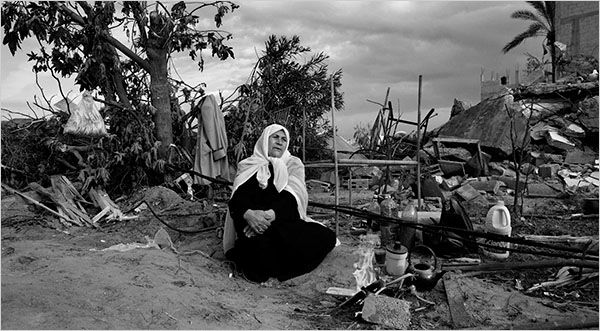
By far the most disproportionate statistic when measuring the Times coverage of the Gaza conflict was its use of images. A total of 59 separate photographs have the feel of a gallery of destruction. Over and over again we are witness to scenes of death and deprivation. Shocking images of dead children and screaming mothers are often the first thing we see in a Times article.
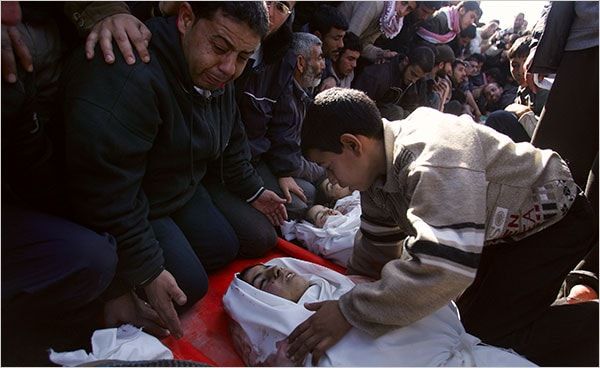
While such sensationalism is clearly more compelling, is this really an objective way to tell the story of the conflict? Is it any wonder that most of the world accepts the narrative of an unrestrained massacre of Palestinian civilians when confronted by these type of images time and again in one of the world’s most influential newspapers?
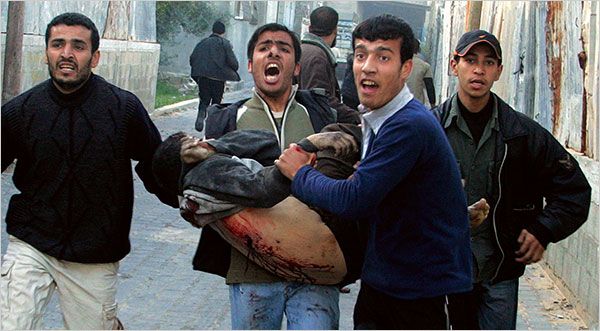
During the time period we studied, only ten images could be said to be representing the Israeli experience. But a picture of a roofed playground reinforced to withstand a rocket attack or a Sderot home with a hole in the ceiling pales in comparison to the images of Palestinian children. In the war of images, the Palestinian cry of “massacre” drowns everything else out.
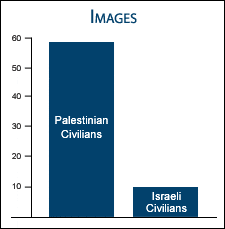
Beyond the Gaza Conflict
The Gaza conflict ended on January 20. Since then, there have been numerous Middle East issues that the Times has covered, including the Israeli elections, US President Obama’s Cairo Speech, and Israeli PM Netanyahu’s endorsement of a demilitarized Palestinian state. These were mostly stra
ight news stories that do not lend themselves to subjective reporting in the same way the Gaza conflict did.
The Times does, however, label Israeli politicians such as Netanyahu, “hawkish” and Foreign Minister Avigdor Lieberman as an “ultra-nationalist” while never applying the same consistency in describing Palestinian leaders such as Mahmoud Abbas. Despite the fact that Abbas has heaped praise on terrorists and whose official media and education system offers a constant stream of viscious anti-Semitism. (For more, see below and on the website of Palestinian Media Watch.) Wouldn’t it be more truthful to describe Abbas as “hawkish” (or perhaps something a bit stronger)?
However, there have been two in depth issues not covered in the most objective manner by the Times. The first is that of Israeli soldiers’ claims of human rights abuses during the Gaza conflict, and the second is on the nature of Israeli settlements.
Dead Cows and Urban Myths
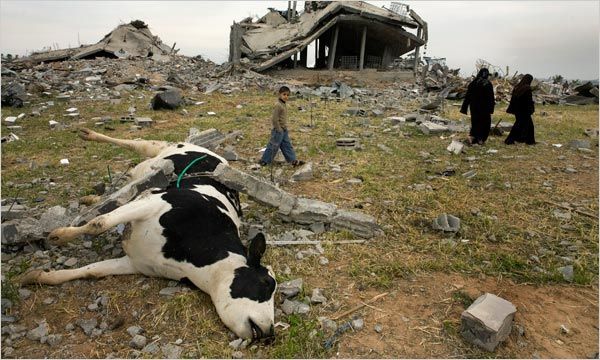
We have previously documented how much of the mainstream media jumped on and reported as fact what were purportedly eyewitness accounts of Israeli soldiers committing atrocities in Gaza. The Times was no different. The first article carried the headline “Soldiers’ Accounts of Gaza Killing Raise Furor in Israel.” Underneath the headline, there is an image of what we are told is a destroyed Gazan elementary school. The destruction of a school was not, however, the subject of any of the accusations in the article. The article goes on to say:
When asked why that elderly woman was killed, a squad commander was quoted as saying: “What’s great about Gaza you see a person on a path, he doesn’t have to be armed, you can simply shoot him.”
The Times failed to explain in that article that the quotation was based on a tape recording of one soldier saying what he had heard third-hand but had not witnessed himself. In fact, it appears that the quotation was based on other, subsequently discredited articles that appeared in the Israeli press, and not on any first person reporting on the part of the Times. The Times followed up the next day with an article clarifying this.
Another article appeared a few days later with the headline “Israel Disputes Soldiers’ Accounts of Gaza Abuses.” This headline ran with the above image of destroyed Palestinian houses and a grotesque dead cow that had been killed (one would assume) by Israeli shelling. As with the first article on the subject, there was no allegation that Israel had deliberately destroyed Palestinian livestock. Did the Times just have another shocking image that they wanted to use, regardless of relevance to the article? The caption of the photo includes a quotation from an Israeli colonel who says “I’m not saying that nothing bad happened.”
Yet, the full quotation can be found in the article:
I’m not saying that nothing bad happened. I heard about cases where people shot where they shouldn’t have shot and destroyed houses where they shouldn’t have destroyed houses. But the proportion and effort and directions we gave to our soldiers were entirely in the opposite direction.
The segment of the quotation that the Times pulls out and uses to caption the story is a misrepresentation of what the colonel was saying. Combining a snippet of a quotation and a graphic, yet unrelated image undermines the facts of the story — namely that further investigation had shown that the incidents did not occur and were “urban myths.”
What are Settlements?
The issue of Israeli settlements features prominently in Times coverage. Especially given the prominence of settlements to recent discussions between the United States and Israel, the media has a duty to accurately inform world opinion about the true nature of Israeli settlements, irrespective of personal views on what is certainly not a consensus issue.
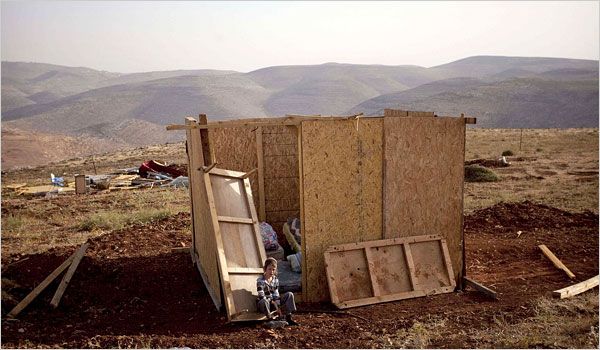
The Times’ reporting does make the important distinction between the handful of illegal Israeli outposts and established settlements. However, its selection of images does not. The above image shows an outpost that had no electricity or running water and was home to seven or eight individuals before it was dismantled by the Israeli police.
Yet this image was chosen to highlight a generalized story on settlements. The story says:
There are now nearly 300,000 Israeli settlers living in the West Bank in addition to 200,000 Israeli Jews living in East Jerusalem, also taken in that war. Since the Palestinians hope to build their state in the West Bank, Gaza and East Jerusalem, they accuse Israel of making that goal impossible through settlement building.
The conclusion any uninformed reader would draw from the image and article is that there are 300,000 Israeli settlers living in rudimentary dwellings on rocky hilltops. However, this is very far from the truth. The vast majority of the 300,000 Israeli settlers referred to by the Times do not live in such places. Most live in large cities replete with apartment buildings, schools, shopping malls and industrial areas. Many of these communities are built on land that is subject to legitimate Jewish historical claims.
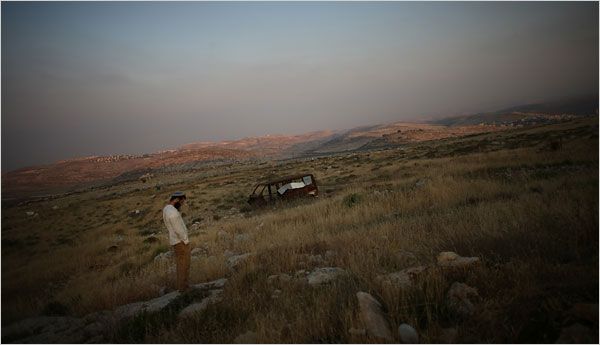
Instead of pictures showing the kind of communities that over 95 percent of Israeli “settlers” live in, the Times treats us to images of tiny, illegal outposts. These are not the communities that the government of Israel is pressing to continue building. In fact, Israel sees these outposts as unlawful and has pledged to remove them.

In a photo slide show under the misleading title “Settlers in the West Bank“, all but one of the pictures shows Israelis living, praying, and rioting in these types of outposts. Some pictures are of Palestinian casualties of “settler violence.” Yet, these photos hardly capture the reality of life for the overwhelming majority of Israeli residents of communities beyond the Green Line. Perhaps the pictures of the 300,000 Israelis living in established cities don’t make compelling pictures?
What the Times Doesn’t Cover
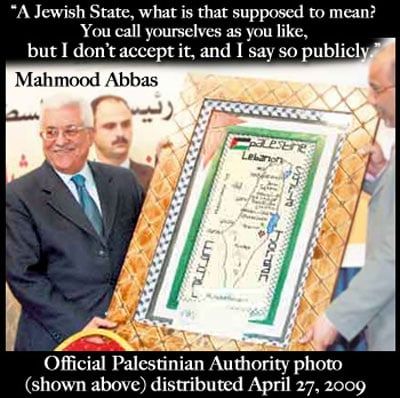 Bias is not only indicated by what the media covers, but is also apparent by what the media decides not to cover. By any objective standard, the issue of halting Palestinian incitement is a major part of the peace process. Under the Road Map and Oslo Accords, the Palestinian Authority agreed to put an end to anti-Israel incitement.
Bias is not only indicated by what the media covers, but is also apparent by what the media decides not to cover. By any objective standard, the issue of halting Palestinian incitement is a major part of the peace process. Under the Road Map and Oslo Accords, the Palestinian Authority agreed to put an end to anti-Israel incitement.
Yet every day, official Palestinian government agencies and media are filled with the most extreme anti-Israel incitement. This incitement is a direct violation of Palestinian obligations and a major obstacle to peace.
As documented by Palestinian Media Watch:
Terrorist Dalal Mughrabi led the most deadly terror attack in Israel’s history. 37 civilians, 12 of them children, were killed in her 1978 bus hijacking. The Palestinian Authority has turned this terrorist into a celebrated hero and role model, as schools, summer camps, and sports tournaments are all named after her. Her attack was celebrated by the Fatah spokesman as “the most glorified sacrifice action in the history of the Palestinian-Israeli struggle.” [Al-Ayyam, July 13, 2008] The PA celebrated the 31st anniversary of the killings with an hour-long TV special.
PA leader Mahmoud Abbas plays an active part in this glorification of terror, as in naming this center for her:
“Yesterday the Hebron Building Committee inaugurated a computer center named after the Martyr Dalal Mughrabi. Present at the event were President Mahmoud Abbas’s advisor… inaugurating the center, funded by a contribution from the President’s [Abbas’s] Bureau and she is called the “heroic fighter Dalal Mughrabi.” .” [Al-Ayyam, May 5, 2009]
Additional Anti-Israeli incitement — as documented in detail below by Palestinian Media Watch (www.palwatch.org) — includes:
Despite the overwhelming evidence of ongoing official Palestinian anti-Israel incitement, from January 1, 2009 until the end of June, the New York Times did not find it appropriate to publish a single story on this subject. (The last article the Times published on this topic was April 2008.)
Conclusion
We began this study with the New York Times’ claim that rather than simply tell the Palestinian or Israeli narrative, they would cover the “whole story” and not just the “parts that sell.” Yet time and time again, we see headlines, selective eyewitness accounts and images that frequently mirror the Palestinian viewpoint. While some of the articles themselves are more balanced in content, the selection of headlines, quotations and images frame the impact of the article.
If there is one change that we can push the New York Times to adapt, it is to urge them to include a balanced selection of eyewitness accounts in Israel and Gaza. The Times should not just serve to document Palestinian suffering while ignoring that of Israelis.
If you want to try and get a letter to the editor published in the New York Times, send it to [email protected]. To contact the Times to offer feedback, go to its online member center and fill out a short form. You will have to register for free with the Times to do so.

